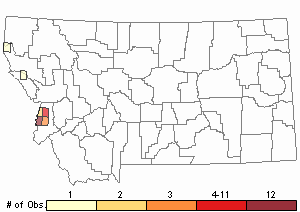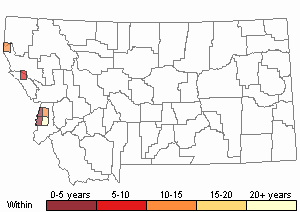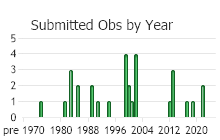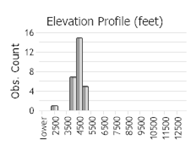View in other NatureServe Network Field Guides
NatureServe
Montana
Utah
Wyoming
Idaho
Wisconsin
British Columbia
South Carolina
Yukon
California
New York
Sandweed - Athysanus pusillus
State Rank Reason (see State Rank above)
Known in Montana from a limited area of the Bitterroot Mountains. Only three occurrences have a large number of indivuals and several occurrences have populations of spotted knapweed and/or cheatgrass established. Invasive weeds may threaten the long-term viability of the species in Montana.
- Details on Status Ranking and Review
Population Size
Score2 - Small: Generally 2,000-10,000 individuals.
Range Extent
Score3 - Local Endemic or Very Small Montana Range: Generally restricted to an area <10,000 sq. miles (equivalent to the combined area of Phillips and Valley Counties) or <6 Sub-basins (4th code watersheds) Range-wide OR limited to one Sub-basin in Montana
Area of Occupancy
Score2 - Low: Generally occurring in 4-10 Subwatersheds (6th Code HUC’s).
Environmental Specificity
Score1-2 - Moderate to High.
Trends
ScoreNA - Rank factor not assessed.
CommentTrends are unknown, though may be declining due to impacts to habitat quality, particularly from invasive species.
Threats
Score2-3 - High to Very High.
Intrinsic Vulnerability
Score1-2 - Moderate to High Vulnerability.
Raw Conservation Status Score
Score
11 to 14 total points scored out of a possible 16 (Rarity factors and threats only).
General Description
Sandweed is an annual with slender stems, up to 15 cm tall, that are simple or sparingly branched from near the base. The alternate, lance-shaped leaves, 6-20 mm long, have toothed margins and are stalked below but sessile above. Foliage is covered with simple and branched hairs. Miniscule white flowers are born on short, spreading stalks in open, unbranched inflorescences at the ends of the stems. The four white petals are ca. 2 mm long, and the sepals are only 1 mm long. The broadly pear-shaped fruits, 2-3 mm long, are covered with hooked hairs and borne on reflexed stalks.
Phenology
Flowering in April-May.
Diagnostic Characteristics
The annual habit and drooping, pear-shaped fruits covered with hooked hairs make this species distinctive.
Species Range
Montana Range
Range Descriptions

 Native
Native
Range Comments
S. B.C. to CA, east to MT, ID, and UT. Peripheral.
Observations in Montana Natural Heritage Program Database
Number of Observations: 31
(Click on the following maps and charts to see full sized version)
Map Help and Descriptions
Relative Density

Recency



 (Observations spanning multiple months or years are excluded from time charts)
(Observations spanning multiple months or years are excluded from time charts)
Habitat
Vernally moist, shallow soil of steep slopes and cliffs in the lower montane zone.
National Vegetation Classification System Groups Associated with this Species
Forest and Woodland
Low Elevation - Xeric Forest and Woodland
Montane - Subalpine Forest and Woodland
Grassland
Lowland - Prairie Grassland
Sparse and Barren
Sparse and Barren
Stewardship Responsibility
Threats or Limiting Factors
STATE THREAT SCORE REASON
Reported threats to Montana's population of Sandweed refer to populations where non-native plants are established (MTNHP Threat Assessment 2021). Sandweed is restricted to small areas of open habitat where direct competition with Cheatgrass (Bromus tectorum) and Spotted Knapweed (Centaurea stoebe) is likely to lower plant viability.
References
- Literature Cited AboveLegend:
 View Online Publication
View Online Publication MTNHP Threat Assessment. 2021. State Threat Score Assignment and Assessment of Reported Threats from 2006 to 2021 for State-listed Vascular Plants. Botany Program, Montana Natural Heritage Program, Helena, Montana.
MTNHP Threat Assessment. 2021. State Threat Score Assignment and Assessment of Reported Threats from 2006 to 2021 for State-listed Vascular Plants. Botany Program, Montana Natural Heritage Program, Helena, Montana.
- Additional ReferencesLegend:
 View Online Publication
View Online Publication
Do you know of a citation we're missing? Lesica, P., M.T. Lavin, and P.F. Stickney. 2012. Manual of Montana Vascular Plants. Fort Worth, TX: BRIT Press. viii + 771 p.
Lesica, P., M.T. Lavin, and P.F. Stickney. 2012. Manual of Montana Vascular Plants. Fort Worth, TX: BRIT Press. viii + 771 p. Lesica, P., M.T. Lavin, and P.F. Stickney. 2022. Manual of Montana Vascular Plants, Second Edition. Fort Worth, TX: BRIT Press. viii + 779 p.
Lesica, P., M.T. Lavin, and P.F. Stickney. 2022. Manual of Montana Vascular Plants, Second Edition. Fort Worth, TX: BRIT Press. viii + 779 p.
- Web Search Engines for Articles on "Sandweed"





